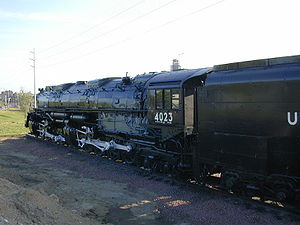
4-8-8-4
Encyclopedia

Whyte notation
The Whyte notation for classifying steam locomotives by wheel arrangement was devised by Frederick Methvan Whyte and came into use in the early twentieth century encouraged by an editorial in American Engineer and Railroad Journal...
for the classification of steam locomotive
Steam locomotive
A steam locomotive is a railway locomotive that produces its power through a steam engine. These locomotives are fueled by burning some combustible material, usually coal, wood or oil, to produce steam in a boiler, which drives the steam engine...
s by wheel arrangement
Wheel arrangement
In rail transport, a wheel arrangement is a system of classifying the way in which wheels are distributed beneath a locomotive.. Several notations exist to describe the wheel assemblies of a locomotive by type, position, and connections, with the adopted notations varying by country...
, a 4-8-8-4 is a locomotive with a four-wheel leading truck, two sets of eight driving wheel
Driving wheel
On a steam locomotive, a driving wheel is a powered wheel which is driven by the locomotive's pistons...
s, and a four-wheel trailing truck.
Other equivalent classifications are:
UIC classification
UIC classification
The UIC classification of locomotive axle arrangements describes the wheel arrangement of locomotives, multiple units and trams. It is set out in the International Union of Railways "Leaflet 650 - Standard designation of axle arrangement on locomotives and multiple-unit sets". It is used in much...
: 2DD2 (also known as German classification and Italian classification)
French classification: 240+042
Turkish classification
Turkish classification
In the Turkish classification system for railway locomotives, the number of powered axles are followed by the total number of axles. It is identical to the Swiss system except that the latter places a slash between the two numbers.Thus0-6-0 becomes 33...
: 46+46
Swiss classification: 4/6+4/6
The equivalent UIC classification
UIC classification
The UIC classification of locomotive axle arrangements describes the wheel arrangement of locomotives, multiple units and trams. It is set out in the International Union of Railways "Leaflet 650 - Standard designation of axle arrangement on locomotives and multiple-unit sets". It is used in much...
is refined to (2′D)D2′ for Mallet locomotives.
The only 4-8-8-4 steam locomotives were the Union Pacific 4000 "Big Boy" Class
Union Pacific Big Boy
Big Boy was the name of the Union Pacific Railroad's 4000-class 4-8-8-4 articulated steam locomotives, built between 1941 and 1944 by American Locomotive Company...
.
The UP Big Boys were an expansion of the 4-6-6-4 "Challenger
Union Pacific 3985
Union Pacific 3985 or UP 3985 is a four-cylinder simple articulated 4-6-6-4 Challenger-type steam locomotive owned by Union Pacific Railroad. The UP 3985 locomotive was built in 1943 by the American Locomotive Company of Schenectady, New York...
" type articulated locomotive. Although their wheels were an inch (25 mm) smaller than those of the Challengers, they were still able to sustain high speeds. Adding four driving wheels increased the pulling power of the locomotive and reduced the need for helper locomotives over steep grades.
Other American railroads considered buying 4-8-8-4s, including the Western Pacific Railroad
Western Pacific Railroad
The Western Pacific Railroad was a Class I railroad in the United States. It was formed in 1903 as an attempt to break the near-monopoly the Southern Pacific Railroad had on rail service into northern California...
, which already rostered large 2-8-8-2s and 4-6-6-4s, but diesel locomotives were gaining popularity and soon were able to displace these monster locomotives.

